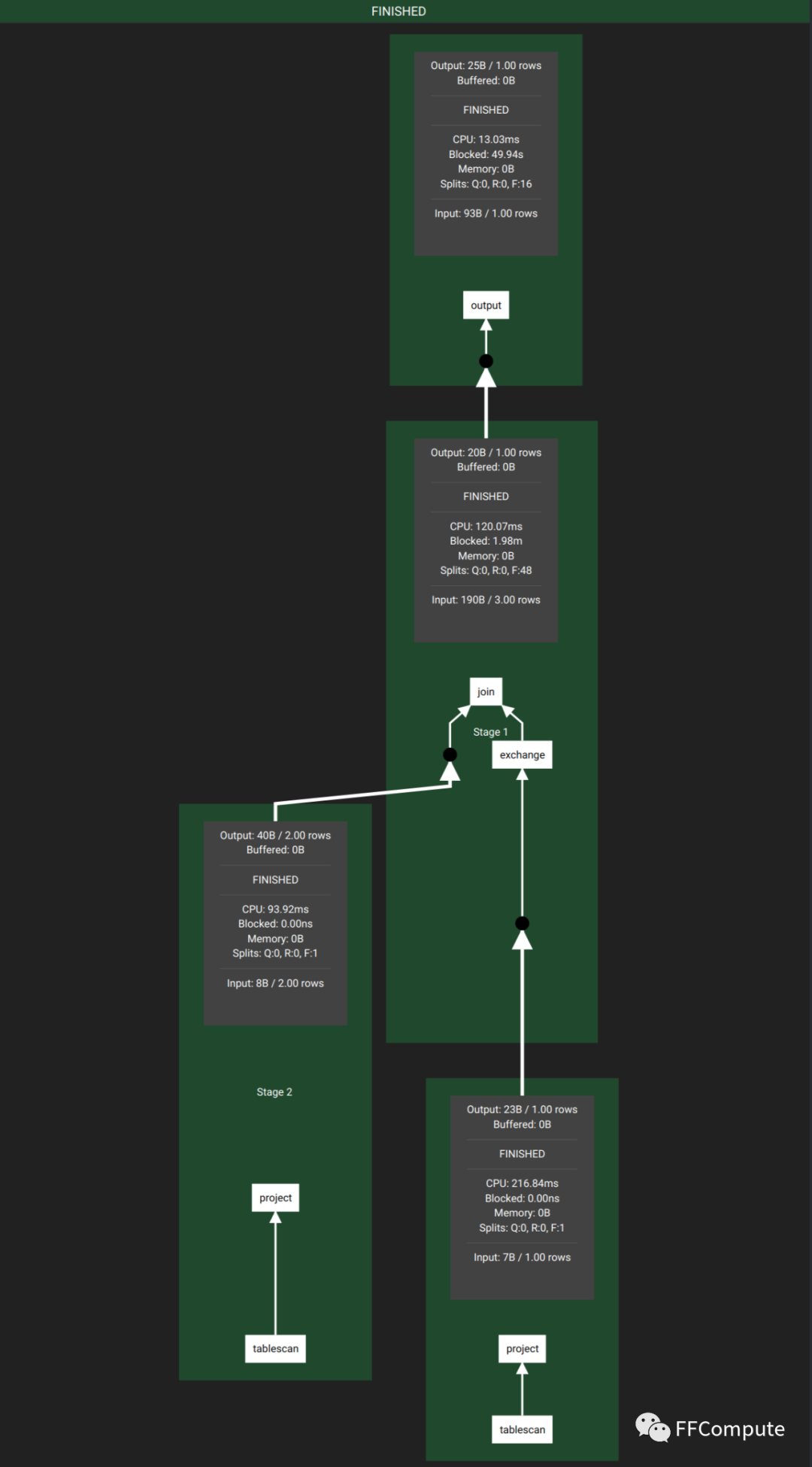Presto调度task方式:
-
public final class SystemPartitioningHandle -
implements ConnectorPartitioningHandle -
{ -
private enum SystemPartitioning -
{ -
SINGLE, -
FIXED, -
SOURCE, -
SCALED, -
COORDINATOR_ONLY, -
ARBITRARY -
} -
}
常见的场景主要包含SINGLE、FIXED及SOURCE类型,其中SINGLE表示最后数据的汇总输出,FIXED表示中间数据的计算,如JOIN等,SOURCE类型表示与源数据打交道的类型。
以下SQL为例:
-
select * from (select * from 1test join 2test1 on 1test.id = 2test1.123id);
其执行计划为:

如上图所示,左右两个stage调度task时都是SOURCE类型,中间为两张表JOIN,其为FIXED类型,最上面的output为SINGLE类型,做最后的汇总输出。
无论哪种类型,在调度task时,都要选择Worker,那其是怎么选择Worker的呢?
根据上面我们提到的Presto调度task方式,可以划分为两类:非源头fragment和源头fragment
非源头fragment
依赖SystemPartitioningHandle策略,通过当前集群可用节点以及hash partition count配置(query.initial-hash-partitions,默认为100)来共同确定该fragment需要的节点个数, 之后再调用 NodeSelector 选出Worker。逻辑为下:
-
public NodePartitionMap getNodePartitionMap(Session session, NodeScheduler nodeScheduler) -
{ -
NodeSelector nodeSelector = nodeScheduler.createNodeSelector(null); -
List<Node> nodes; -
if (partitioning == SystemPartitioning.COORDINATOR_ONLY) { -
nodes = ImmutableList.of(nodeSelector.selectCurrentNode()); -
} -
else if (partitioning == SystemPartitioning.SINGLE) { -
nodes = nodeSelector.selectRandomNodes(1); -
} -
else if (partitioning == SystemPartitioning.FIXED) { -
nodes = nodeSelector.selectRandomNodes(getHashPartitionCount(session)); -
} -
else { -
throw new IllegalArgumentException("Unsupported plan distribution " + partitioning); -
} -
-
checkCondition(!nodes.isEmpty(), NO_NODES_AVAILABLE, "No worker nodes available"); -
-
ImmutableMap.Builder<Integer, Node> partitionToNode = ImmutableMap.builder(); -
for (int i = 0; i < nodes.size(); i++) { -
Node node = nodes.get(i); -
partitionToNode.put(i, node); -
} -
return new NodePartitionMap(partitionToNode.build(), split -> { -
throw new UnsupportedOperationException("System distribution does not support source splits"); -
}); -
}
根据上面代码,我们可以看到SINGLE及FIXED会根据调度task的类型选择Node,最终调用的是同一个函数,函数逻辑为:
-
public List<Node> selectRandomNodes(int limit, Set<Node> excludedNodes) -
{ -
return selectNodes(limit, randomizedNodes(nodeMap.get().get(), includeCoordinator, excludedNodes)); -
}
源头fragment
源头fragment依赖于其connector id,以hive connector为例,其通过discovery服务注册上来,具体实现是在DiscoveryNodeManger#refreshNodesInternal。在真正Schedule task时,为split分配Node时,采用DynamicSplitPlacementPolicy策略调用以下接口:
-
public static ResettableRandomizedIterator<Node> randomizedNodes(NodeMap nodeMap, boolean includeCoordinator, Set<Node> excludedNodes) -
{ -
ImmutableList<Node> nodes = nodeMap.getNodesByHostAndPort().values().stream() -
.filter(node -> includeCoordinator || !nodeMap.getCoordinatorNodeIds().contains(node.getNodeIdentifier())) -
.filter(node -> !excludedNodes.contains(node)) -
.collect(toImmutableList()); -
return new ResettableRandomizedIterator<>(nodes); -
}
可以看到无论是哪种选择方式,最终都绕不开NodeMap,那NodeMap怎么来的,由上文代码可以看到,其需要创建nodeScheduler.createNodeSelector,代码如下:
-
public NodeSelector createNodeSelector(ConnectorId connectorId) -
{ -
// this supplier is thread-safe. TODO: this logic should probably move to the scheduler since the choice of which node to run in should be -
// done as close to when the the split is about to be scheduled -
Supplier<NodeMap> nodeMap = Suppliers.memoizeWithExpiration(() -> { -
ImmutableSetMultimap.Builder<HostAddress, Node> byHostAndPort = ImmutableSetMultimap.builder(); -
ImmutableSetMultimap.Builder<InetAddress, Node> byHost = ImmutableSetMultimap.builder(); -
ImmutableSetMultimap.Builder<NetworkLocation, Node> workersByNetworkPath = ImmutableSetMultimap.builder(); -
-
Set<Node> nodes; -
if (connectorId != null) { -
nodes = nodeManager.getActiveConnectorNodes(connectorId); -
} -
else { -
nodes = nodeManager.getNodes(ACTIVE); -
} -
-
Set<String> coordinatorNodeIds = nodeManager.getCoordinators().stream() -
.map(Node::getNodeIdentifier) -
.collect(toImmutableSet()); -
-
for (Node node : nodes) { -
// 略
这里我们找到源头了,Presto的机器是由Discovery管理的,上文nodeManager即DiscoveryNodeManager封装了Discovery服务接口,Discovery维护Worker死活信息。
知道Worker怎么选择后,之后就会使用stage的不同的调度器来开始下发task和split,同样根据SystemPartitioningHandle的不同,源头分为SourcePartitionedScheduler、FixedSourcePartitionedScheduler,非源头使用FixedCountScheduler进行调度,其在调度某个stage时下发多少task到Worker以及split下发过程,我们将在后续介绍。






















 1323
1323











 被折叠的 条评论
为什么被折叠?
被折叠的 条评论
为什么被折叠?








